Types and varieties of dracaena
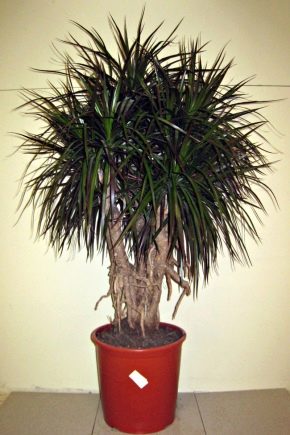
Dracene is an extensive family of woody plants, moisture-loving and thermophilic. All varieties are distinguished by a spectacular appearance of two-colored or spotted leaves, crowning a bare trunk in the form of a cap. Small greenhouse trees are used for home decor and public spaces. Dracaena perfectly purify the air, filling it with oxygen.
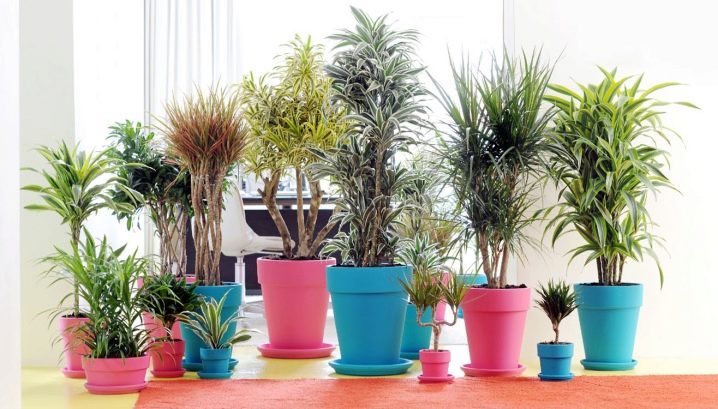
General description of the plant
Dracaena tree-like belongs to common indoor plants, resembles a tropical palm tree in its appearance. Dracaena flower growers love for their external grace and unpretentiousness. Refers to long-lived plant crops.
Botanical scientists count up to one hundred species of tropical plants; a number of them are grown at home. The island of Madagascar is considered the birthplace of dracaena.
In their natural habitat, various subspecies can be found in Africa and South Asia, the subtropics of the European South.
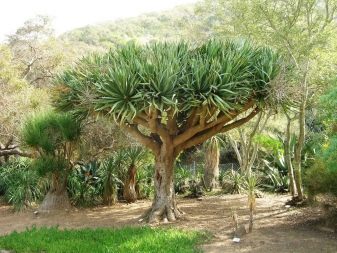
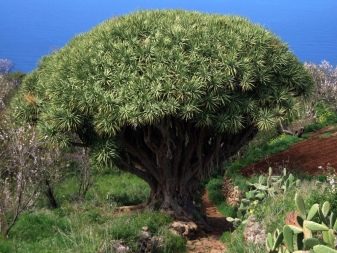
Medium-sized dracaena are up to two meters high. A thick stem or bare trunk adorns the top of succulent leaves, effectively edged along the edge in white. The leaves reach a length of up to one and a half meters and have a pointed shape. In the wild, dracaena grow up to 7–11 m, beautiful flowers appear on them, and then fruits. A full seasonal flowering cycle is rare in artificial breeding.
The domesticated potted plant is usually found in a greenhouse, and its stem grows to a height of no more than a meter. A well-rooted dracaena can be taken out into the fresh air in the warm season. The tree belongs to evergreens, therefore it is used for home decoration and decoration of offices, official places and halls.
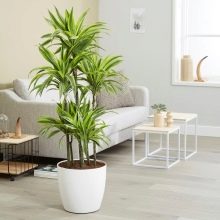
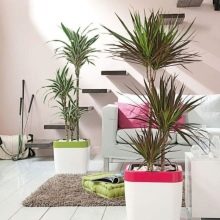

Varieties
There are several types of treelike dracaena. What distinguishes them from each other is the size and type of the tree trunk, the length and width of the leaves, as well as their shape. All varieties are grown in greenhouses and bred in greenhouses. A limited number of species and subspecies are suitable for the home. The most common are the most beautiful varieties of dracaena.
Fragrant
In its natural environment, it blooms, emitting a long-lasting pleasant aroma of mown hay. In artificially created conditions, it grows up to 2 meters. The barrel is thick and requires support. The foliage is wide, up to 7 cm, dark green or multi-colored. Inflorescences in the form of brushes, greenish-pink or cream. Among the subspecies, stands out "Massangeana"... It is a tree with a crown of arched leaves.
There is a yellowish stripe in the middle of the dark green leaf. The trunk is dense, durable, and accumulates moisture well. At home, the culture quickly reaches a height of 150 cm if properly cared for.
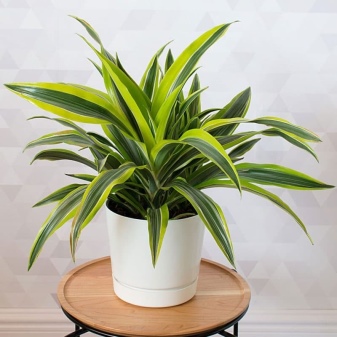
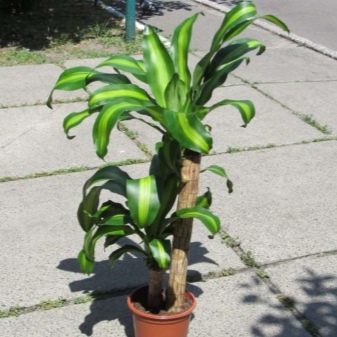
Edged
Bordered, or "Marginata" ("Magenta"). Subspecies include cultures called Bicolor and Tricolor, as well as Colorama... The leaves are large, up to 60 cm, bordered with reddish brown or with a bright stripe inside, pointed in shape. Lush growth is concentrated at the top, like a palm tree. The stem is glabrous, up to two meters high, non-uniform. The spectacular plant is widespread, easy to breed at home.
It grows slowly, propagating by stems and cuttings.
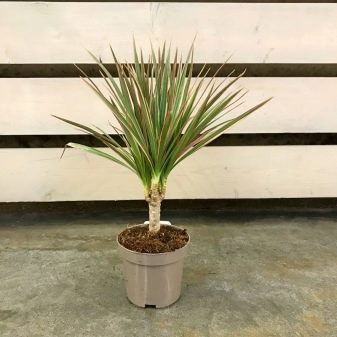
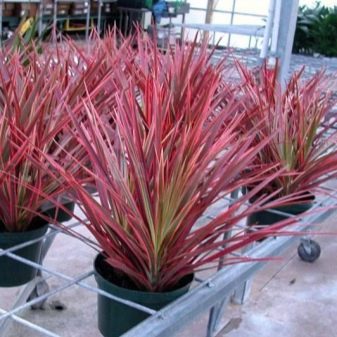
Godsef
Godsef, or "Surculosis"... It mainly grows in Africa. It looks like a wide bush, the shoots form branches.Leaves in the form of an oval, spotty, with blurred whitish areas, light green, shiny, grow on thin branches. Distinctive features of "Godsefa" - abundant growth of shoots to the sides and the absence of a trunk, unusual color leaves.
They singled out this variety as often used for decorating premises. The flowers are yellowish, with a delicate aroma, appear in November - December. When kept in a room, a shoot-forming shrub grows from 50 to 250 cm. The stems are thin, resembling a reed.
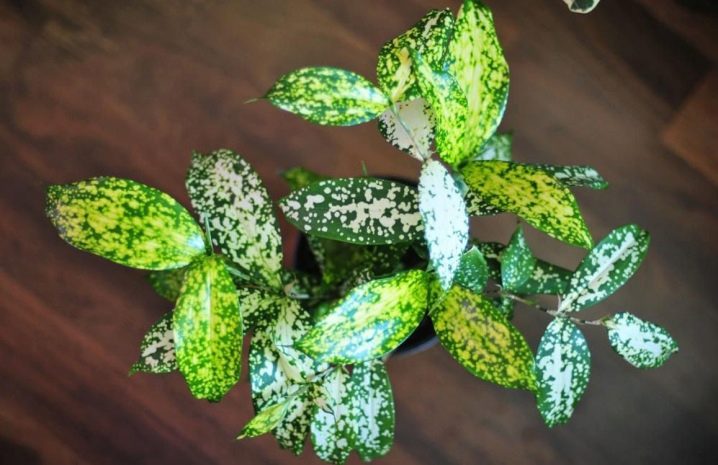
Mix
It is also called the "tree of happiness" and combines a mixture of specific features. Homeland - Central America. Obtained by crossing several varieties, so the external characteristics can be varied. The tint color of the stripes on the leaves varies from yellow to red and brown, the width may vary. An extremely unpretentious plant, perfect for home.

Hooker
Hooker, or aletrimis. Another name is "Cordilina Rumfa". A small (one and a half - two meters) tree, comes from the Agavov family. The trunk branches out, resembling a panicle.
It has elongated green leaves, which are dense to the touch, with veins and white edges, wavy and narrow at the base, from 60 to 80 cm. It belongs to the most unpretentious plants. Bred in greenhouses. Faint flowers can appear on the Hooker only as a result of stress - this is very rare.
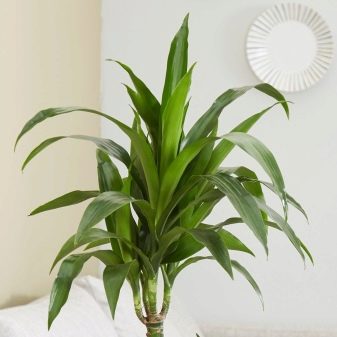
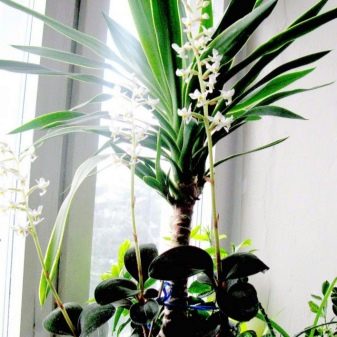
Bamboo
Bamboo, or Sandera. According to Feng Shui, this variety is called the bamboo of happiness, another name for the variety is "Lucky". In China, it is customary to give "Sander" to each other, to cultivate in the house. It can reproduce in water, but under the condition of active fertilizing with fertilizers. So that the roots do not rot, they are poured two to three centimeters, but not completely.
Dracaena "Laki" feels comfortable in water for about 12 months, then transplantation into the ground is needed. Several trunks, planted in one voluminous pot, bend and intertwine with each other in an interesting composition, the leaves are decorated with silver stripes.
Excessive young growth on the trunk must be removed periodically. Loves fresh air and sunlight.
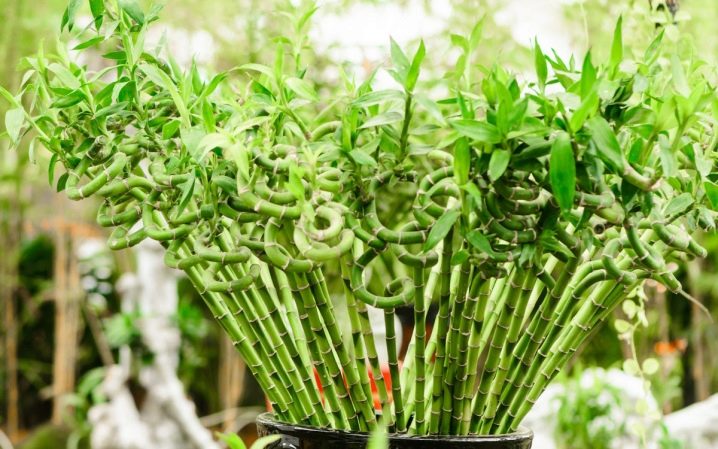
Fragrant
Fragrant, or Hawaiian (bent). The leaf plates adjoin in bundles tightly to the trunk, slightly curving at the ends, they are long and narrow, with a light border. The bushes are voluminous, with a pronounced tropical beauty.
"Song of India" growers like it for its high decorative properties: it has two stripes at the edge of the sheet. Golden Coast also more often than others they choose as a decor, since it has a short trunk, dense large leathery leaves, fixed on petioles. Kanzi has leaves with a longitudinal stripe, white or yellowish.
Variety Dorado originated from Guinea, a culture with dark wide leaf blades. Requires more water for irrigation than narrow-leaved subspecies. Refers to the favorites among indoor crops. "Malayan" belongs to Asian cultures, has unusual leaf plates with a silvery tint. Occasionally blooms with small white buds, reaching a height of 2.5-3 meters.
"Reflexa" prevails on the islands of Madagascar and Mauritius. The branches of a palm tree begin at the base of the trunk, the veined foliage, up to 15 cm long, has a similar flower. To decorate the house, the variety is most often used. "Anita", which is distinguished by graceful twigs and dark juicy leaves.


Shirmonochnaya
With a short trunk, narrow and long leaves (up to 3 cm in width and up to 90 in length).
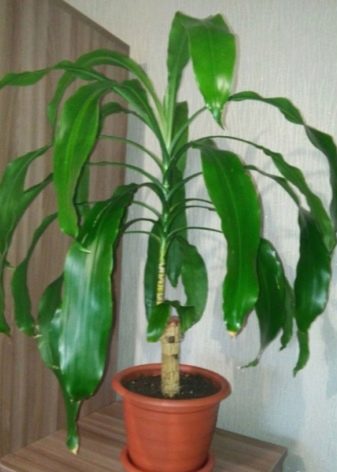
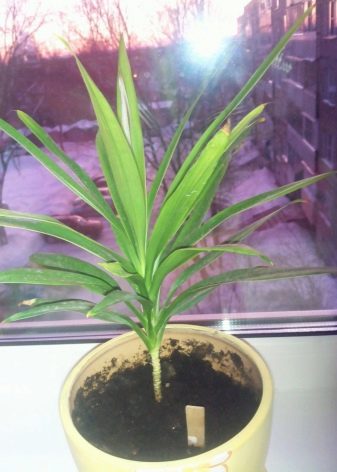
The Dragon
Dragon, or "Canary". Named for its area of growth, it is also found in western Africa. The tree reaches a height of 9-10 m, at home it is possible to grow this species to no more than one and a half meters, placing it in a large flowerpot. The thick, smooth trunk of the dragon tree branches out at the top. Pointed leaves with thorns at the end and a reddish edge that becomes visible in good light.
Variety "Sandera" has a not so high trunk, leaves are decorated with silvery stripes. Homeland subspecies "Cinnabar red" - Socotra island. In nature, it grows on a rocky surface, the crown looks like an umbrella turned inside out with dense branches. Flowers gather in panicles, then fruits - berries appear.

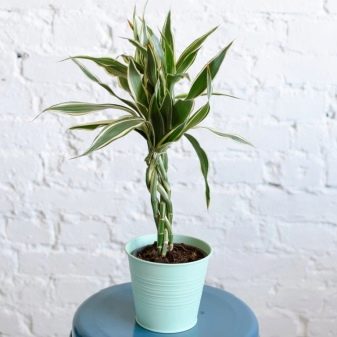
Capitate
A small plant with medium-sized oval leaves, sharp at the ends.
On leaves darker in tone, light green small specks are visible.
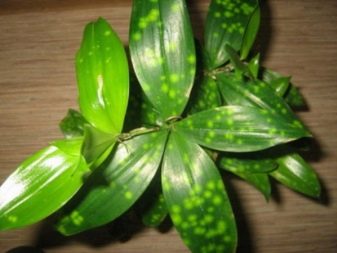

Deremskaya
Known subspecies are Varneschi, Janet. Janet Craig - palm tree, one of the tallest (up to 3 meters), with a thin trunk. On it there is a row of lush bunches of wide dark or yellowish-edged leaves up to one meter long.
In a young plant, the leaves are oriented upward, then, as they grow, they change direction and go down. Lateral shoots are absent. During the flowering period, red buds appear with a white center and a strong, pungent odor.
The plant does not like dust, needs frequent wiping and spraying.
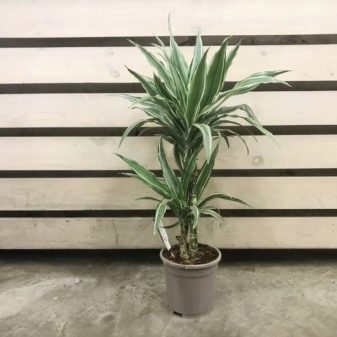
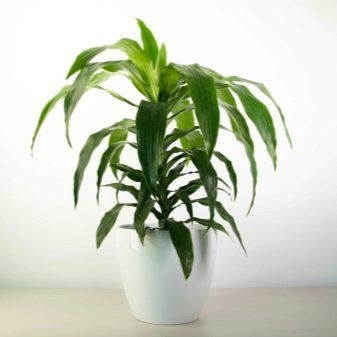
Lime
Low trunk with light green leaves, inside of which there is a dark longitudinal stripe. The stem is not prone to branching, after a few years it becomes bare, and the plant stretches to its full height. During this period, he needs careful care. Then the apex is rooted by cutting off the bare part of the trunk.

Home care
Caring for dracaena is relatively easy. This is especially true for such varieties as edged and deremskaya, "Dragon".
Temperature and humidity
Being a southern plant, dracaena requires warmth, adherence to a certain temperature regime and maintaining sufficient air humidity. The optimum temperature for crop growth should be at least 20 degrees Celsius, the minimum - +160.
If the thermometer drops below +100 Celsius, the thermophilic plant may simply freeze and die. Seasonal changes in heat and cold, sharp gusts of wind are also undesirable.
Watering is required in moderation, without flooding the roots, so that there is no decay. It is best to combine watering with frequent spraying. The drained water remaining in the tray after the procedure is poured out immediately. Then moisture is removed from the inner pockets in the leaves, otherwise decay and foliage may begin to fall.

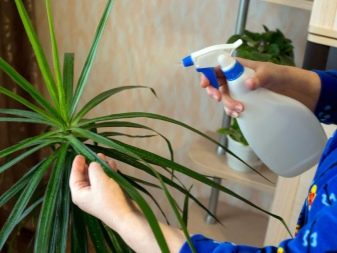
A variety such as "Godsefa" can be found in a room with relatively dry air. The rest of the species do well only in high humidity conditions, as they are tropical plants. In hot weather, when the pot is in a heated room, the leaves and trunk are sprayed at least three times a day.
You can also run over the sheets with a wet cloth.
Lighting
Light dracaena is necessary, but the tree must be protected from direct rays of the sun. If you put it in the back of a well-lit room, close to the window, it will be a great place. You can also leave it on the windowsill, but on the east or west side.
Light and unevenly colored leaves require more light than dark ones. That's why varieties that possess them are more demanding in care.
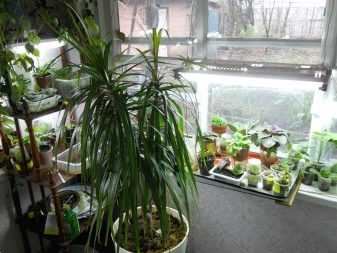
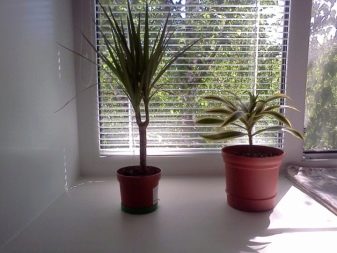
Top dressing
Growth is noticeable from spring to autumn; in winter, the process stops. Therefore, the culture is fed mainly from April to October. You need to purchase mineral fertilizers in specialized stores, apply according to the instructions. Usually, feeding is required once every two to three weeks. In order for air to penetrate into the ground near the roots, the soil of the upper layer is loosened.
Watering
The soil in the tub is left slightly moist, but not filled with water until it becomes a swamp. Standing water from the tap, quite warm (+ 25-300 Celsius), will do. In cold weather, it is heated.
The young are transplanted every spring into flowerpots with a diameter of 20 cm. The soil is the same as for palm trees, with a drainage layer. Water the plant with a stimulant after planting.
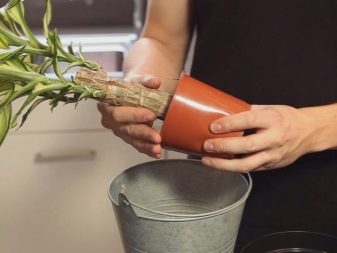
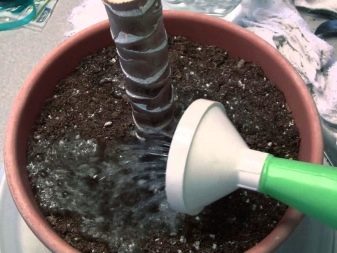
In the course of growing a crop, flower growers sometimes have problems - the appearance of the foliage changes. This signals a lack of light, moisture, heat, or an excess of them.
- Leaflets become soft and begin to curl... This happens if the temperature regime is not observed (dracaena froze). You need to move the pot from the windowsill or floor to a place where it is warmer and more light.
- The edges of the leaf become brownish... This indicates that the plant is standing in a draft or the air in the room is not humid enough. In this case, you need to place the dracaena in a calm place, protected from cold air currents. Spraying will help completely restore the appearance.
- Light spots appear. This means that there is too much light, - the intensity of the radiant flux must be reduced. It is necessary to shade the tree, remove it from direct sunlight.
- The lower leaves turn yellow and fall off... The process of dying off aging foliage and replacing it with fresh light green shoots is natural.
Plant care involves the constant removal of withering leaf blades.
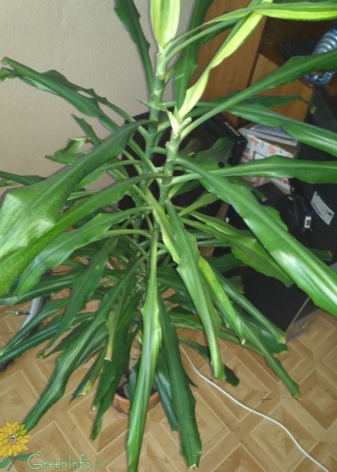
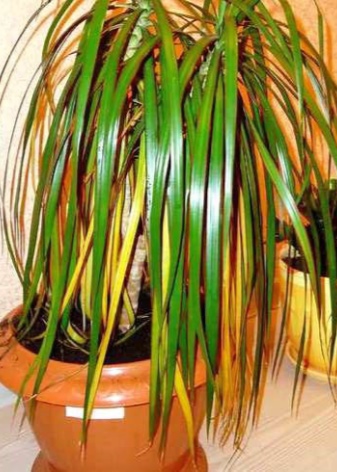
Diseases and pests
It is believed that the culture has good immunity and is resistant to pests. However, there are several insects that affect it destructively.
- Shield. More often than others, this pest can appear on dracaena. Spreading rapidly, the scabbard is introduced into all parts of the plant. A concentrated solution of soap with water and the addition of vodka helps to fight the parasite in the initial stage of infection. If the pest has spread, insecticides are needed.
- Mealybug. This pest does not tolerate the effects of soapy water, therefore, the plant is treated immediately. The appearance of the worm indicates another problem that needs to be found and eliminated.
- Spider mite. Its appearance is evidenced by the cobweb on the back of the foliage, unaesthetic spots and yellow punctures. You can wash off all this under a plentiful shower, then apply insecticidal agents. Ticks attack in conditions of heat, stuffiness and increased dry air.
- Thrips. This is the name of insects no more than a millimeter in size. Tiny black pests leave whitish and translucent-looking spots that appear more and more on the leaves. The fight against thrips begins with abundant and thorough washing, then the plant is treated with karbofos. At an early stage, a yarrow tincture helps.
- Aphid. It settles in the form of colonies of harmful white larvae that absorb all the juices from the plant. The leaves become lifeless, wither and fall off. The plant needs treatment with celandine tincture and decoction of onion husks. Then chemical aphids are used, such as Fitoverm and Neoron.
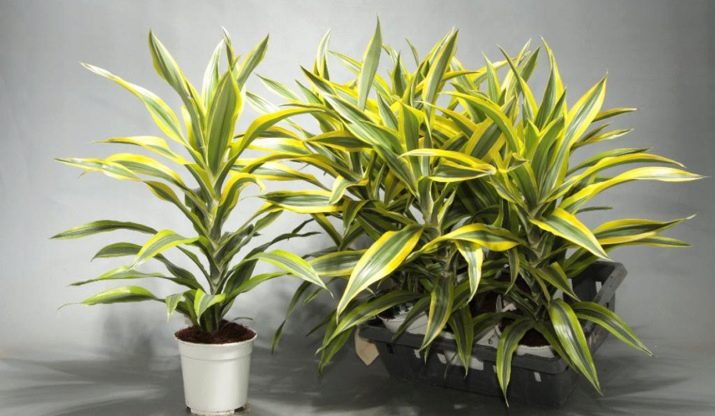


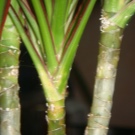
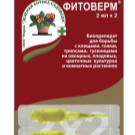

For more information on the types and varieties of dracaena, see the next video.




























The comment was sent successfully.